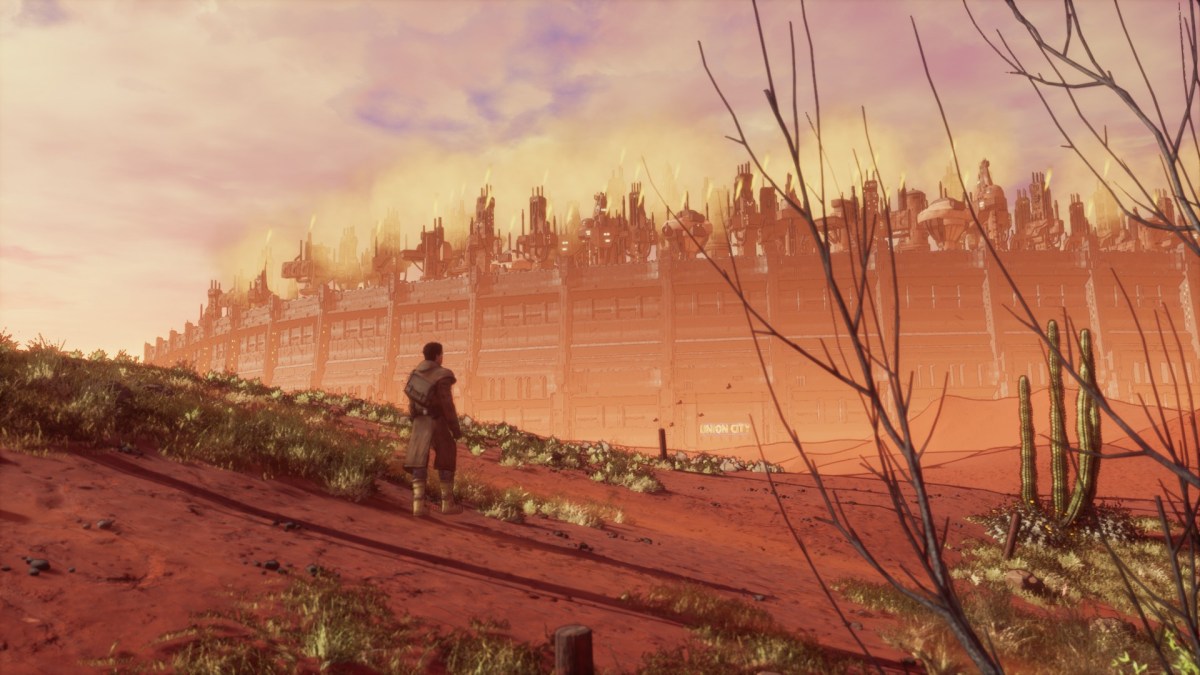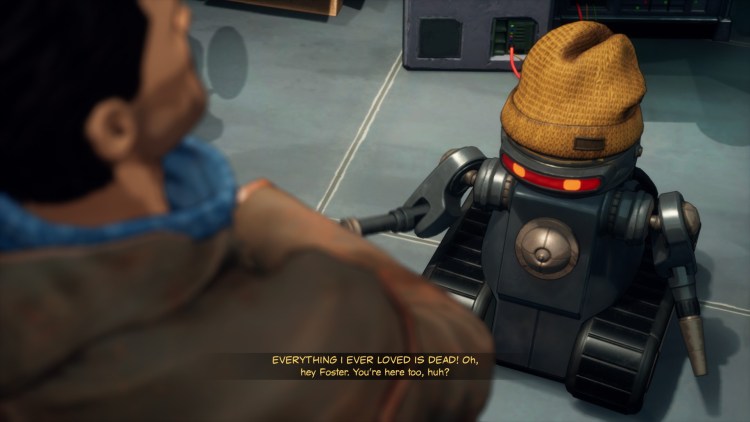With Telltale’s demise, there hasn’t been much of a focus on 3D follow-ups to ’90s point-and-click adventure games. Beyond a Steel Sky, a sequel to the cult classic Beneath a Skeel Sky, nicely fills that void, however. You can tell that the budget wasn’t too huge, as the game has its fair share of technical shortcomings and the repeated use of a smallish amount of areas. But the setting is great, and the dialogue and characters are so well-written and funny that it’s hard to walk away from the game with anything but a smile.
Cleanliness is next to Joeyness
Beyond a Steel Sky takes place a decade after the previous game. Robert Foster has been living in the gap ever since saving Union City. But his village gets attacked by androids and a child gets kidnapped. Not one to take that sort of thing lying down, Foster sets off on the trail and winds up facing down Union City once again. After installing a chip in his hand and stealing a dead man’s ID, Foster gets into the city and is faced with some hard truths about the choices he’s made, witnessing the consequences firsthand.
To put it simply, the story is intriguing. Union City is very much a dystopia inspired by Orwell’s Nineteen Eighty-Four. It’s lorded over by five ministries that see to the needs of the society. Naturally, there are dark secrets hidden beneath the pleasant facade. Despite this, the game is consistently funny. Characters are well-defined and are brought to life by varied, fun character designs and a lot of great vocal performances. Conversations are never dull, as the dialogue is just dripping with wit. I’d frequently talk to anyone in earshot just because I didn’t want to miss a word.
But I do feel that the narrative didn’t dig quite as deep into certain threads as I would have liked. It was satisfying overall, but I walked away a bit disappointed in Robert and his reactions to things that very much existed due to events at the end of the last game. Regardless, the story is the highlight in Beyond a Steel Sky and is worth the price of admission alone.
Gotta hack em all
While the original was mostly a typical point-and-click adventure game that focused on accruing various items and clicking around to see where you could use them, Beyond a Steel Sky focuses on using a hacking device for most of its puzzles. There are occasional items to acquire and use, but there are comparatively few of them. There are typically multiple hackable objects in any given area– holographic ad projectors, robots, vending machines. One of my favorite areas is a museum where you have to move holographic data between points.
While the hacking aspect is fairly clever, it does get repetitive after a while. Most of them simply boil down to swapping an instruction onto a robot in the area, doing something to make said robot move around, before finally swapping that program onto a third thing. Some of these puzzles can get a bit confusing. too. It isn’t always immediately clear what swapping program elements will even accomplish. In the end, you’re left trying to get multiple hacking points within range of your tool at once, which can also be a bit finicky.
But this is made far less problematic by Beyond a Steel Sky‘s hint system. Selecting the hint option in the menu will give you a little tip on how to progress if you’re stuck. Afterward, another will become available in 30 seconds if the initial one wasn’t enough. This is fantastic, as it means that all players will be able to get through the game regardless of their puzzle-solving aptitude. Similarly, anyone who wants to experience the story above all else can just coast on this if they so choose. Most of the puzzles are on the logical side, though, and the hint system is mostly helpful for little bits that aren’t clear.
Get clipped
Beyond a Steel Sky runs in Unreal Engine 4 and has a 3D cel-shaded look. While the game’s visuals have a lot of personality, it’s fairly obvious that there wasn’t a giant budget to work with. As I mentioned earlier, there aren’t that many environments, leaving the game to look dated. Character models often have poor animations and the pedestrians walking around are simply goofy to watch. If you get in their way, their walk animation slows to a crawl as if they got hit with a slow-mo beam. They also clip through each other. There are a lot of robotic animations for the non-robot models indeed.
The game is also not very well optimized considering the nature of the visuals. You can uncap the framerate, but hitting 1440p on a 5700 XT makes it difficult to even reach 60 FPS. At 4k, it was typically in the 20s. I can easily hit 120 FPS in better-looking Unreal 4 games without issue, so this was a bit concerning. There are also some hitches when it comes to selecting options. Robert will occasionally drift away from selectable objects. He remains uncontrollable until he reaches a certain area before describing the object of desire as if he’s standing in front of it.
It’s also often possible to break the game a bit simply by pausing while selecting dialogue choices. That’s a mistake I only made once, however. Beyond a Steel Sky can be played with either a controller or mouse and keyboard and feels fine either way. Certain aspects could just use a bit of work, is all, as could Robert’s running animation, which is jaunty and quite strange.
Twice the sky
While the original game is about six hours long, Beyond a Steel Sky will take most players 10-12 hours to beat. The length of the game feels just right, with no sections dragging on too long. The puzzles can get a bit redundant, but stay consistently fun. There are some technical issues, but the story and world are so enjoyable that I find the game very easy to recommend regardless. Beyond a Steel Sky is positively hilarious and jam-packed with character and memorable moments. And that fact alone makes it stand out very clearly.












Published: Jul 10, 2020 2:00 PM UTC